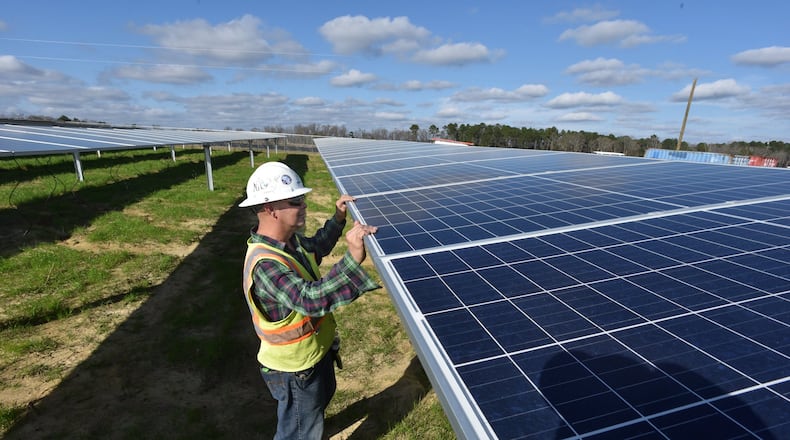Georgia will rely more on the sun to generate electricity as it retreats from its once overwhelming reliance on coal.
The state Public Service Commission’s five members — all Republicans — unanimously directed Georgia Power to make its biggest increase ever in renewables, nearly doubling the solar capacity of the state’s largest utility. The addition — 2,210 megawatts of new capacity from solar panels by 2024 — is enough to power more than 200,000 homes of the company’s 2.6 million customers.
“It’s one of the cleanest and cheapest generation (sources) we can have,” PSC chairman Lauren “Bubba” McDonald said.
He successfully pushed to more than double the amount of solar Georgia Power initially proposed as part of an update to its long-range energy plan. Most of the new solar generation is expected to come from large-scale commercial arrays rather than homeowners' rooftops.
Solar panels produce electricity without emitting carbon, a pollutant that has been blamed for climate change. The commissioners did not cite that issue. They did, though, predict the new solar generation will have lower costs than some other forms of energy.
Still, the savings are not expected to be significant enough for customers to notice a change in their power bills, PSC commissioners said. Meanwhile, rates could rise in the future because of other shifts, including costs tied to the overbudget nuclear expansion at Plant Vogtle and a $2.2 billion rate increase that Georgia Power recently proposed to phase in starting in January.
Natural gas is expected to remain the largest fuel source for Georgia Power.
But coal plants, once the dominant power source in Georgia and favored by President Donald Trump, are a shrinking part of the state’s energy mix as they become less economically viable. The PSC agreed with Georgia Power’s recommendation to close five coal-burning units, one at Plant McIntosh near Savannah and four more at Plant Hammond near Rome. The company started winding down operations this year.
PSC Vice Chairman Tim Echols said he wanted to add solar before federal investment tax credits for it begin to decline in 2020. “I do not believe Congress and the president will reinstate this credit. So Georgia needed to take advantage of the low prices while available.”
If the tax credits fall, the solar additions could be the last big wave for Georgia Power for years to come, Echols said.
Georgia Power particularly heralded the PSC’s approval of 80 megawatts of battery energy storage, which could help store solar power.
The project “is critical to growing and maximizing the value of renewable energy for customers as we increase our renewable generation,” Allen Reaves, the Atlanta-based company’s senior vice president, said in a press release.
The PSC also directed Georgia Power to add 50 megawatts of biomass power, which is typically generated by burning wood. While such energy production tends to be more expensive, PSC commissioner Jason Shaw said biomass plants could create jobs in rural areas and support the forestry industry.
Environmental groups generally heralded the solar additions and a PSC decision to grow energy efficiency programs.
Kurt Ebersbach of the Southern Environmental Law Center said in an emailed statement that McDonald has cemented his legacy as the leading solar champion in Georgia.
Others said the state needs much more solar and should make deeper cuts in use of fossil fuels.
“Although this result is more than the company first proposed, it’s still much less than Georgia needs,” wrote Stephen Stetson of the Sierra Club’s Beyond Coal campaign in Georgia.
Why it matters:
Nearly doubling the size of Georgia Power’s solar energy program provides a cleaner energy source for the state’s largest utility and, according to state regulators, less expensive power for the company’s 2.6 million customers.
About the Author
Keep Reading
The Latest
Featured



